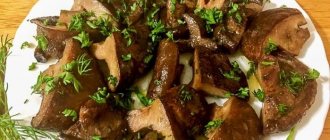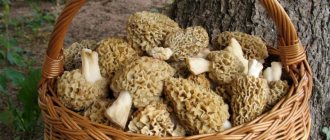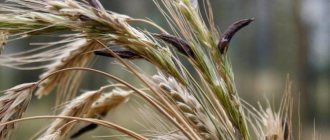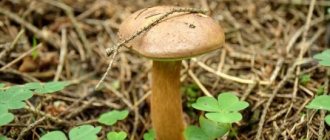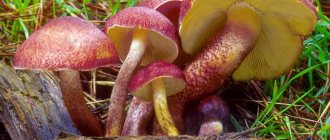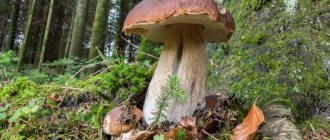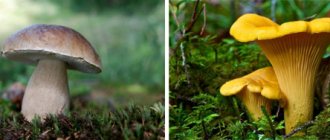Mushrooms
0
1807
Article rating
Kira Stoletova
It is important for a real mushroom picker to be able to distinguish edible fruiting bodies from inedible ones. On a person’s path, one may encounter a mushroom called “dunka” (popularly known as “dunka”). It is highly toxic and has the ability to accumulate heavy metal salts.
The dangers of eating pig mushrooms
hat
0
Source:
The mushroom cap can have different sizes, it all depends on the age and place of growth. The largest specimens reach 15 centimeters. Young mushrooms have a convex cap, slightly curved at the edges. The older the mushroom, the lower the central part becomes. Over time, the cap takes on the appearance of a funnel, tightening towards the base. The fruit margins can also be funnel-shaped, but sometimes they are simply drooping, ribbed, or wavy. The color of young mushrooms is usually olive or olive-brown. Over time, they become increasingly gray, acquiring a rusty or grayish-brown color. The surface can be wet, damp, dry, sticky, glossy - it all depends on the weather and conditions of the place where the mushroom grows.
Varieties
Today, ten varieties of pigs have been identified. Moreover, each type contains harmful substances in different quantities. Some of them are classified as poisonous. The most common ones will be discussed below.
Also learn about growing champignons in a greenhouse.
Thin pig
The thin pig (in Latin Paxillus involutus) is distinguished by a number of characteristics:
- curved upward or straight upper body of the mushroom;
- color gray-olive or bright brown;
- velvety to the touch with curved fluffy edges;
- tasteless yellow, tender and fluffy pulp, odorless;
- a plate-like layer of rare red-yellow plates. Sometimes they are united by membranes, creating an openwork outer layer;
- large legs with a total length of 1–2 cm and 9 cm in height.
This type of mushroom is inedible.
Alder pig
A type of edible pigs concentrated in deciduous forests with high soil moisture and the obligatory presence of alder.
The view can be described as follows:
- convex cap with a diameter of 8–15 cm with thin curled edges;
- then it is leveled and pressed in, the edges are leveled or lowered;
- dry to the touch, fluffy with small cracks;
- the color is ocher-brown, brown with yellowish or scarlet-brown. Sometimes it takes on an olive tint that darkens when pressed;
- the surface of the mushroom is lamellar;
- plates of medium or strong density, oblong with joints in the center of the base;
- the leg is cylindrical, yellow-scarlet or green-brown, cross-section - 1–2.5 cm, and height up to 8 cm;
- tender compacted pulp of yellow or yellow-red color. Darkens when cut.
The mushroom can be found from July to September. Belongs to the category of edible.
Ear-shaped pig
The ear-shaped, or as it is also called panus-shaped, pig is described as follows:
- a rough, dense cap with a diameter of up to 12 cm;
- fluffy or smooth fan-shaped surface;
- rough, ragged, or wavy edges;
- color varies from yellow-brown to dark red;
- elastic-rubbery pulp of yellow-white or pale chestnut color, which turns brown when cut;
- The ear-shaped sow in most cases does not have a leg, or it grows, but is very short.
This species is characterized by a pine smell. It is relatively edible.
When and where do they grow?
Dunki grow in large groups. Moreover, the appearance may differ slightly from the standard description depending on the place where the group is located. They settle on the edges of forests or near swamps, as they love moisture very much. They settle on fallen trees or stumps. Widely distributed in our territories. They grow actively from early summer to autumn, when it is not yet very cold. They bear fruit mainly from June until October. Therefore, almost the entire summer and autumn period they can be found in the territories of deciduous and coniferous forests.
What does a pig look like?
A detailed description of the pig mushroom helps to accurately identify this type of mushroom, so as not to collect it together with edible ones. The biggest difficulty is that dunka does not have the characteristic signs of poisonous varieties. But the mushroom still has some distinctive features that make it stand out in a forest clearing.
Read also: Orange mushroom
Pigs grow in large groups. They usually spread in forest edges or swampy areas. The sizes of young and adult mushrooms vary greatly. The hat can reach a diameter of 4 to 15 cm. It has a fairly bright color. Small young mushrooms are usually orange-brown, while older ones take on a rusty tint. The surface of the dunka in dry weather can be smooth with slight pubescence; after rain it becomes dull and slightly sticky.
The pig's hat changes throughout life. At first it is round, convex, fleshy, with slightly concave edges. As this species matures, it develops a flattened top that collapses in the center. The stem of this mushroom is quite short. It has a solid matte structure and a gray-brown tint.
Svinushka does not have a pronounced mushroom smell and taste. Its pale yellow flesh is quite dense, juicy and soft. The plates under the cap are thin and thick. They are well separated from each other and from the fruiting body.
Photos of duneks may be different. The appearance of this mushroom largely depends on the place where it grows. Most often it can be found in deciduous and coniferous forests next to fallen trees and on stumps.
This mushroom loves moisture and is able to accumulate it in the pulp. Therefore, the easiest way to identify a pig is to press on the base of the cap or a cut of the fruiting body. If we are talking about a dangerous species, the mushroom will darken.
Dunki are very unpretentious. They can be found in any region where there is sufficient moisture for their growth and development. The period of active fruiting is from late June to October. Therefore, throughout the summer-autumn period, mushroom pickers must be careful while collecting these forest gifts. Before you go on a quiet hunt, it is better to carefully study the photos of poisonous mushrooms again, so as not to risk your health and the well-being of your loved ones.
Why are mushrooms dangerous?
0
Source:
The lectin toxin contained in pigs, entering the blood, provokes the decomposition of red blood cells, thereby causing hemolytic anemia, if the dose is small, then nephropathy, jaundice and even kidney failure in acute forms. Particularly high sensitivity to poison in children and people after illness. Mushrooms are dangerous if a person has urolithiasis and a tendency to allergies. It is also reported that muscarine, a specific alkaloid found in red fly agarics, was also found in Solokha. In large quantities it causes vomiting, diarrhea, poisoning, bradycardia, and visual impairment. In especially severe cases, it leads to breathing problems and pulmonary edema. Promotes drug addiction. However, the effect of the toxin is not as obvious as, for example, in the toadstool. Poisoning can occur over a fairly long period of time, it all depends on the number of mushrooms, their age and the condition of the body. In addition, the mushroom is an accumulator of radioactive isotopes, especially cesium and copper, which are very dangerous to health
What to do with dunki after collection
Although, unlike other mushrooms, dunki suffer less from worm invasion, they still need to be sorted out.
- It is necessary to remove overripe, dry or spoiled mushrooms, as well as leaves and other debris.
- To check for pests, you need to trim the bases of the legs. It is not necessary to remove the skin from the cap, like butterfish. If dirt has stuck to it, just scrape it off with a brush or knife.
- The sorted crop must be filled with cold water with the addition of a small amount of salt. This composition makes it easier to clean debris from mushrooms. After half an hour, the pig can be washed and placed in clean water for another 30 minutes.
- The water should be changed at least three more times, with an interval of several hours. This procedure allows toxins and harmful substances to leave the product.
Since ancient times, thin pork has been eaten in Rus'
- After the last soaking, the mushrooms must be sorted by size and the stems separated from the caps. It is recommended to leave small mushrooms whole, and cut larger caps into pieces.
- Before preparing a dish of duneks, they should be boiled for half an hour with the addition of salt. Since mushrooms contain pigment, the water and the mushrooms themselves will darken during cooking. Then the water must be drained and the dunki rinsed well. Then pour clean salted water again and keep on fire for another 30 - 40 minutes.
- The final step is straining the mushrooms. Ready-to-cook pigs can be fried or salted (marinated) using the hot method.
Also read: Poisonous mushrooms: determine the type and learn to distinguish them from edible ones
Despite the fact that experienced mushroom pickers use pig mushrooms in preparing various dishes, medicine refutes the fact that they are harmless
Signs of poisoning and first aid
0
Source:
The problem is that it is very difficult to determine poisoning. But there are still some signs that not everything is in order with the body and, perhaps, the mushroom was poisonous: in small quantities and with prolonged use, the toxin causes a reaction reminiscent of an intestinal infection. At the same time, the body can very rarely cope with it and suppress the effect of the poison, so the condition lasts for quite a long time; malaise for a long period; if a lot of mushrooms have been eaten, the reaction occurs within 2-4 hours and is highly intense; vomiting, diarrhea, increased peristalsis are the most obvious signs of poisoning; the appearance of bruises and bleeding, pallor; blood tests reveal a change in the number of red blood cells, an increase in bilirubin is observed; jaundice begins to develop; the pupils narrow, vision is impaired; a person may experience shortness of breath, lacking air; heart rhythm is disrupted. Sometimes, if the poisoning was minimal, decreased immunity, drowsiness, malaise, vomiting and diarrhea continue for a long time, but go away on their own. Sometimes a person may not even know what caused this condition. In particularly difficult cases, diagnostics in a hospital cannot be avoided. It is necessary to take blood tests. In cases of jaundice or renal failure, hospitalization is required.
Reviews from the network
Source:
To eat or not to eat thin pork is a long discussion that is periodically raised on mushroom forums. Briefly, the theses are as follows: 1. Pork has been eaten for centuries and not bothered. I, too, ate it throughout my childhood, and my parents ate it, and their parents too. It was almost the main mushroom. 2. Someone (who is unknown) at the end of the last century showed that the pig contains certain antigens that cause the formation of antibodies in the body, and derived from this the theory that the pig is poisonous, and fatal. Since then, by decree of the Presidium of the Supreme Soviet of the USSR, the pig was converted into poisonous mushrooms. 3. People who know about this (item 2) basically stopped eating pork, guided by the principle “who knows, maybe it’s true.” Me included. That is why there are so many more pigs in the forests. 4. Many considered the ruling on the toxicity of the pig to be excessively far-fetched and continue to eat it, guided by the fact that before everyone always ate it and had no problems. 5. Whether to eat pork or not is everyone’s personal choice. For example, it’s psychologically safer for me not to eat it. And in general, mushrooms interest me more from a scientific point of view than from a gastronomic one, so I don’t suffer from this omission at all.
Taste qualities of dunek
Since ancient times, thin pork has been eaten in Rus'. Young individuals have a good, but not pronounced taste. Experts classify the mushroom in the fourth category of taste qualities.
Since overgrown specimens accumulate toxic substances that cause poisoning, pig mushroom is on the list of conditionally edible mushrooms. It is known that when heated, the poison is destroyed, but poisoning occurs among gourmets who consume this type of mushroom.
